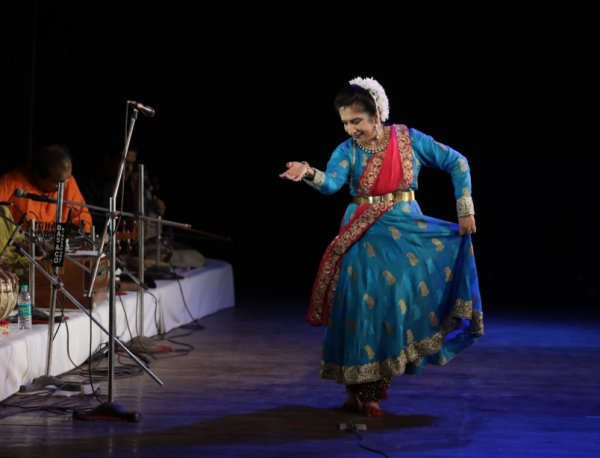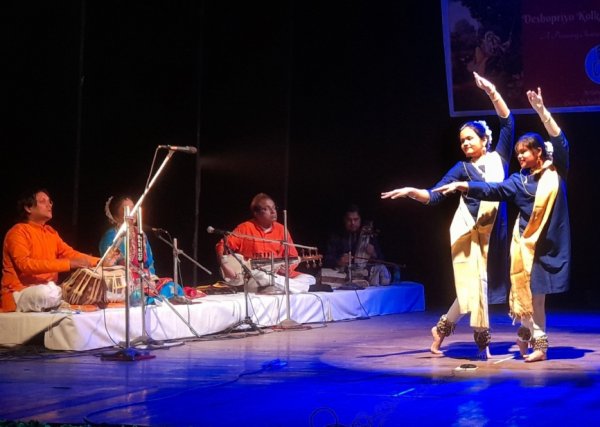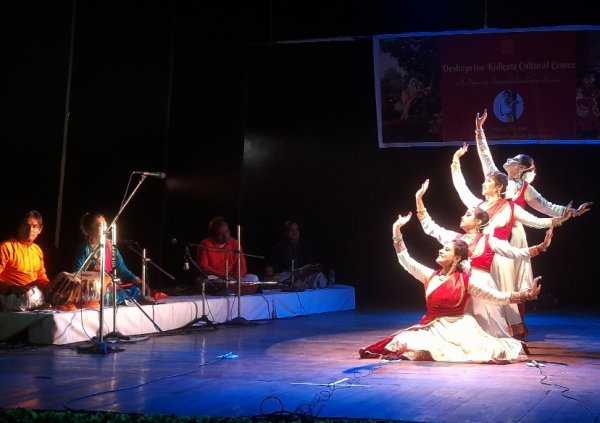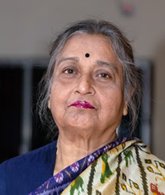
|   |

|   |
Samarpan by Deshopriyo Kolkata Cultural Centre - Dr. Nita Vidyarthi e-mail: nitavidyarthi@gmail.com Photos courtesy: Susmita Banerjee April 13, 2023 Kathak institution Deshopriyo Kolkata Cultural Centre founded by acclaimed Kathak dancer Susmita Banerjee organised an evening of solo and group performances titled 'Samarpan' at the Gyan Manch, Kolkata. It was a tribute and complete "samarpan" or surrender to all those Gurus from whom Susmita Banerjee had learnt. The audience had the privilege of watching a bouquet of scintillating Kathak items by the renowned dancer in the first half and a number of choicest of pure dance (nritta) items choreographed by Banerjee and performed by her senior students in the second. Susmita, a postgraduate in English literature, is a choreographer and dance researcher who trained with Pt Ram Narayan Misra, Pt Vijay Shankar and Maya Chatterjee. She submitted herself briefly to rigorous coaching under Pt Birju Maharaj and revived the "Katha Shaili" of Kathak under the able guidance of Maharaj-ji. A stylish and dignified dancer, she is known for her Sanskrit productions like the Kumarasambhavam, parts of Meghadootam and Malavikagnimitram to name a few, where she had sketched a wide variety of interpretation of movements, animated nritta items in tala patterns strictly within the form. Apart from her Gurukul in Kolkata that welcomes students from different parts of the world, Susmita Banerjee has recently started the 'Kerala Gharana', a platform for teaching and sharing of Indian art and culture. Closely attached to Spicmacy and honoured with many awards, she keeps a low profile. Her recent information packed, excellent quality documentary film, 'I Can Hear You Dance' on four legendary Kathak Gurus - blazing stars of yesteryear, who made a tremendous contribution to the dance form through the guru shishya parampara - brought forth their life, their struggle, and their art and was well received by the dance fraternity as well as the art lovers.  Susmita Banerjee The evening started with the entry of a total surrender (samarpan) to the Almighty and her gurus with raised hands while paying homage to them and seeking their blessings with the refrain of "Hari Om". With movements of 'arati' set to tatkaar on entry, the dancer transported herself to a Brahmananda bhajan, "Jai Shankara Kailashpati Shiv" - a Shiva Vandana. The invocation to begin with is generally not a compulsory component of a Kathak recital but may be invoked for God or one's own teacher. With her skill and gestures in the impactful Shiva Vandana, Susmita was able to work up a serene and elevating effect to the ideal opening piece of the recital. In the numbers that followed, the presentation of ideas and images were attempted effortlessly. She moved on to a series of quality nritta pieces with the composition of her Gurus with perfect balance of laya, tala, ang and bhava so essential in Kathak. And these appeared highlighted separately and distinctly in her successive numbers. According to Susmita, her Gurus have steered her to the beautiful world of rhythm - 'anubhuti', through various experiences and she has lived her life through these bols. This was her Anjali. She began her segment of stunning exploration of the complex tala structure and rhythm with nritta in taal Dhamar of 14 matra or beats and brought out the mood of the tandava and lasya ang to her performance of the intra-forms based on mnemonic syllables of a number of varieties with 'choti choti' (short spanned) tihai, upaj or improvisation, ladi or rela which she calls "ankahi". Here the structure is so designed and beautifully maintained that it comes to 'sam' and then pulls itself to the approaching tihai. A beautiful Amad "dha taka thunga" composed by Pt Vijay Shankar won applause sharing the credit with her accompanist - the ace senior tabaliya and dancer Subir Thakur. At this juncture she made an interesting statement while performing that, "I call it - Jaaney bhi do (let it go) - Mera dha to samney mein hai - sam samney hai; (my dha stands in front of me) - Prabhu is in front of me - Sam is Krishna, Sam is Chhand, Sam is laya - Sam is destination". What stood out was a seldom seen semi-circular beautiful sideways elbow movement, as also inflexion or twists of her wrist (kalai). Not being rigid with the gharana divide, she took liberty in presenting her favourite 'Anaghat Paran' which she had learnt from the Jaipur Gharana maestro Pt Om Prakash. Some old rich compositions Talangi and Nrityangi were also performed, as the nritta and nritya are integral parts of Kathak. The imagery of tandava and lasya elements, heavy and light or soft moods of the bol Kathikataghina in taal Dhamar was presented with equal command when each phrase with the same words were beautified with different inflections like vir ras and then lasya - soft and delicate. She went on nonstop with different moods with the paran of Kathikataghina like chanting a mantra in life when it comes with different moods. A novel experience indeed! A scintillating "farmaish" (request) offered by Subir Thakur had great import in terms of laya-tala and the bhava in the Ghorsawar (horse riding) tihai which played well on the enjoyment of the audience in general. After the riveting Dhamar experience, Teentaal drut compositions were Susmita's homage to Guru Vijay Shanker. She expressed her gratitude and her learning experience as she performed paramelu, from different sounds in nature, variety of instruments, bands, percussions and pakhawaj. Undoubtedly the understanding between the two artistes resulted in demonstrating the vivaciousness of these well preserved traditional compositions. Subir Thakur expressed his wish to play some of Pt Vijay Shankar's compositions and proved his prowess in a short tabla solo. Debapriya Samanta, a senior student of Susmita, showed good co-ordinating power of delivering the parans in the deliberate pace. Taking a break from the wizardry and proficiency of the variety of rhythmic elements, Susmita's abhinaya piece set to the popular Thumri "Jab se Shyam sidharey" portraying the virahotkanthita nayika saw a sense of flow of emotions of Radharani not being able to bear the pain of separation from Krishna. Her agony was expressed with a bounty of vigorous footwork and tatkaar. She concluded her recital with the energetic 'Ganga Avataran', a beautifully choreographed piece by the dancer herself, embellished with fine footwork and chakkars, beginning with the Kavit "Saghana ghata chayi himgiri shikhara" and set to recorded music. With a sense of elegance on the onset of the item visualising the descent of Ganga on Lord Shiva's matted locks, the body passed on to serene relaxation accompanied by perfection of equilibrium offering the imagery of the flow of Ganga and its course. She was accompanied by well-known musicians with vocals by Sudakhshina Manna Chatterjee, sarod by Sunando Mukherjee, sarangi by Kamalesh Mishra and on the tabla by Subir Thakur.   Students of Susmita Banerjee With tabla accompaniment by Timirbaran Chakravarty and the same set of musicians and their guru Susmita Banerjee on the bol paran, the senior students in the second half of the evening presented a bouquet of Kathak numbers beginning with "Shri nand nandana nachata sudhang" from Srimad Bhagvata. The Natwari nritya describes the dance of Sri Krishna on a full moon night where by 'divine arrangement' and magical spell, Lord Krishna lures the gopis from their homes with the melody of his flute and dances with each of them. A picturesque display of nritya in this Raslila was by Debapriya Samanta and Sampurna Sen. To showcase items in Teental, Sangita Sarkar and Satabdi Nath joined in and Jhaptaal was presented by three slightly younger learners. The choreographed version of the song "Sun sun saware" by Shreya Ghoshal and Pranab Biswas came as a surprise. 'Taal Tarang' originally by Susmita Banerjee was a fascinating exploration of myriad moods with various jatis into an intrinsic whole. It was an infusion of percussion instruments of the North and South like ghatam, tabla and the like. The students proved their skills and solid training with the clarity of presentation and grip on rhythm in the riveting Tarana in raag Jog concluding with a stunning stance.  Dr. Nita Vidyarthi is a veteran critic of performing arts and writes on dance, music and theatre in leading publications. |